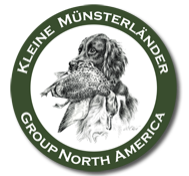For more than 100 years the strengths of the Kleine Münsterländer (KlM) have been in pointing furred and feathered game which the dog has found through a search. The dog searches intelligently and systematically, using the prevailing winds and in visible contact of its handler. The Kleine Münsterländer has an excellent nose, good tracking ability on live and fallen game, gives “laut” on sight of game and often just on the scent of game. The breed can thus be utilized equally well before and after the shot. And this is true, whether in the field, in water or in the forest. The Kleine Münsterländer has command of the search for fallen game and retrieving, as well as blood tracking, the search for game, also in dense cover, with a gun.
Because of the broad range of hunting capabilities the Kleine Münsterländer is numbered among the versatile utility hunting dogs. As a result of its intelligence and ability to learn, the KlM can adapt quickly to a wide variety of hunting conditions. The Kleine Münsterländer can specialize in upland hunting, as well as hunting for water fowl, blood tracking or the forest search (Stöberjagd) and hunting wild boar. As hunting success depends upon natural abilities and experience, and experience comes from training, so too will a KlM specialized in a particular type of hunting naturally lose its capabilities for universal and versatile hunting purposes. This is true for an individual dog. But if several generations are bred for a specific type of hunting, then the genetic natural ability as a versatile hunting dog, with all the characteristics associated with these abilities, will slowly but surely change, and the KlM will lose its classic profile.
In testing, there are differences between natural ability and performance tests. All tests results are centrally recorded in the breed registry, and then, in Germany, integrated into the centralized breed database “Dogbase”. The natural ability tests are a prerequisite for use in future breeding, along with the breed show. Young dogs should take their natural ability tests preferably in the first year after birth. During this time the dog has had no extensive hunting experience, which allows a better evaluation of the inherited, natural abilities.
The test subjects in the Spring (VJP) demonstrate the KlM’s field search, pointing, handling of a hare track, the quality of the nose, pointing ability, desire, intelligence and strength of nerves at gunfire. If possible, sight “laut” (Sichtlaut) or scent “laut” (Spurlaut) shall also be determined as a necessary prerequisite for future use in breeding.
The test subjects of the natural ability test in the Fall (HZP) partially repeat the subjects of the Spring (field search, pointing, quality of nose). In this test, the progress of the dog since the Spring test can be recognized. Furthermore, the water subjects with the flight-disabled, living duck (if legally permitted) and the retrieving subjects on a game drag are also included in the test.
The test subjects of the Association Utility Test (VGP) are very comprehensive and are spread out over two days. This test is a challenging performance test and is called the “Master Test” for versatile hunting dogs. This test simulates nearly every kind of work that occurs in normal versatile hunting situations and places special emphasis on the obedience of the dog. Dogs, which have passed this test, can be used for select breeding, subject to other details.
In addition to these three tests, there are still several special performance certificates and tests, which can also be entered on the pedigree und thereby increase the value of the dog. In most cases, however, these are not relevant for breeding. Examples are reliability in retrieving a fox, obedience and proficiency in the hare track, outstanding search and retrieving, success in difficult blood tracks on different kinds of deer or wild boar, the successful search of wild boar capable of defending itself, etc.
Unfortunately, international comparison of national testing regulations in the member clubs of KlM-I is very difficult. It is also a major problem that in many countries not all of the versatile hunting subjects described above, and which make up the performance abilities of a KlM, are tested. The KlM are only tested in special performance abilities, above all on feathered game. In such cases, the value of the dog is only determined by this specialization. The long-term risk of this approach has already been described. Even worse are places where the KlM may be bred without any kind of performance ability test.
In these countries no real performance breeding of the Kleine Münsterländer can be conducted. KlM-I is making an effort to find solutions in the future with the individual national member clubs and the F.C.I., so that the versatile performance profile of the classic KlM is not lost.
(Used by permission of the author, Bernd-Dieter Jesinghausen, former President of the Verband für Kleine Münsterländer Vorstehhunde e.V. and the founder of KlM International.)

